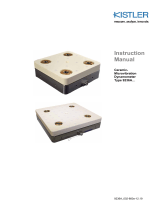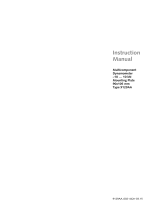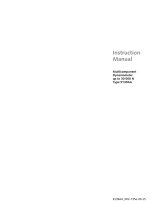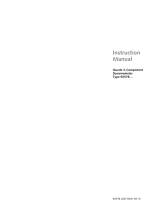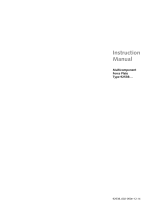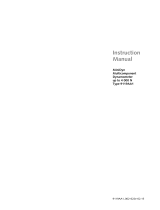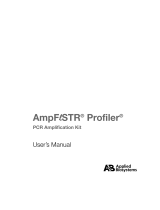Page is loading ...

Instruction
Manual
Multicomponent
Force Link Set
Type 9366CD
9366CD_002-412e-04.23
Fz
Fx
Fy


Foreword
9366CD_002-412e-04.23 Page 1
Foreword
Information in this document is subject to change without
notice. Kistler reserves the right to change or improve its
products and make changes in the content without obligation
to notify any person or organization of such changes or
improvements.
© 2023 Kistler Group. All rights reserved. Except as expressly
provided herein, no part of this manual may be reproduced
for any purpose without the express prior written consent of
Kistler Group.
Kistler Group
Eulachstrasse 22
8408 Winterthur
Switzerland
Tel. +41 52 224 11 11
Fax +41 52 224 14 14
info@kistler.com
www.kistler.com

Multicomponent Force Link Set, Type 9366CD
Page 2 9366CD_002-412e-04.23
Content
1. Introduction............................................................................................................................... 4
2. Important Information ............................................................................................................... 5
2.1 For Your Safety ................................................................................................................................ 5
2.2 How to Treat the Instrument ............................................................................................................ 6
2.3 Tips for Using the Instruction Manual ............................................................................................... 6
2.4 What Happens After Modifications? ................................................................................................. 6
3. General Description of the Instrument .......................................................................................... 7
3.1 What Does a Multicomponent Force Plate Do? ................................................................................ 7
3.2 Functional Principle ........................................................................................................................... 8
3.3 Design of the Multicomponent Kit .................................................................................................... 9
4. Assembly, Installation and Putting Into Operation ........................................................................ 10
4.1 Important Remarks.......................................................................................................................... 10
4.2 Design Variants of Force Plate......................................................................................................... 11
4.2.1 Size of Top Plate ................................................................................................................ 12
4.2.2 Suggested Cover Plate Materials....................................................................................... 13
4.2.3 Thickness of Top Plate ....................................................................................................... 13
4.2.4 Weight of Top Plate........................................................................................................... 13
4.2.5 Measuring Ranges ............................................................................................................. 14
4.2.6 Natural Frequency ............................................................................................................. 15
4.2.7 Cover Plate Mounting Dimensions .................................................................................... 16
4.3 Mounting Set on Cover Plate .......................................................................................................... 20
4.4 Installing the Force Plate ................................................................................................................. 24
4.5 Basic Circuity and Cabling of the Measuring System....................................................................... 25
4.5.1 Measuring System ............................................................................................................. 25
4.6 Triaxial Force Measurement............................................................................................................ 26
4.7 6-Component Force Measurement ................................................................................................. 28
5. Operation ................................................................................................................................ 29
5.1 Range selection ............................................................................................................................... 29
5.2 Measuring Small Force Changes...................................................................................................... 29
5.3 Useful Frequency Range .................................................................................................................. 31
5.4 Temperature influences .................................................................................................................. 33
5.5 Polarity of the Measuring Signal ..................................................................................................... 33
6. Maintenance ............................................................................................................................ 34
6.1 Recalibration of Sensor ................................................................................................................... 34
7. Troubleshooting ....................................................................................................................... 35
7.1 Diagnosis and Rectification of Faults ............................................................................................... 35
7.2 Defective Multicomponent Kit ........................................................................................................ 36
8. Technical Data .......................................................................................................................... 37

Content
9366CD_002-412e-04.23 Page 3
9. Annex ...................................................................................................................................... 38
9.1 Glossary ........................................................................................................................................... 38
9.2 Measurement Uncertainty .............................................................................................................. 41
9.3 Linearity .......................................................................................................................................... 42
9.4 Frequency Range ............................................................................................................................. 44
9.5 Influence of Temperature ............................................................................................................... 45
Total pages: 46

Multicomponent Force Link Set, Type 9366CD
Page 4 9366CD_002-412e-04.23
1. Introduction
Please take the time to thoroughly read this instruction
manual. It will help you with the installation, maintenance,
and use of this product.
To the extent permitted by law Kistler does not accept any
liability if this instruction manual is not followed or
products other than those listed under Accessories are
used.
Kistler offers a wide range of products for use in measuring
technology:
Piezoelectric sensors for measuring force, torque, strain,
pressure, acceleration, shock, vibration and acoustic-
emission
Strain gage sensor systems for measuring force and
moment
Piezoresistive pressure sensors and transmitters
Signal conditioners, indicators and calibrators
Electronic control and monitoring systems as well as
software for specific measurement applications
Data transmission modules (telemetry)
Kistler also develops and produces measuring solutions for
the application fields engines, vehicles, manufacturing,
plastics and biomechanics sectors.
Our product and application brochures will provide you
with an overview of our product range. Detailed data
sheets are available for almost all products.
If you need additional help beyond what can be found
either on-line or in this manual, please contact Kistler's
extensive support organization.

Important Information
9366CD_002-412e-04.23 Page 5
2. Important Information
Please keep to the following rules without fail. This will
ensure your personal safety when working, and assure
long, trouble-free performance by the instrument.
2.1 For Your Safety
This instrument has been tested thoroughly and it left
the works in a perfectly safe condition. To maintain this
condition and assure safe operation, the user must
observe the directives and warnings contained in these
instructions.
The multicomponent kit allows to design your own
force plate. General information in this Instruction
Manual refer to the mounted force plate.
The force plate must be installed, operated and
maintained only by persons who are familiar with it and
adequately qualified for their particular tasks.
When it must be assumed that safe operation is no
longer possible, the instrument must be taken out of
operation and secured against unintentional use.
It must be assumed that safe operation is no longer
possible if:
the instrument is visibly damaged,
it no longer functions,
it has been in lengthy storage under adverse
conditions,
it has received rough treatment during transport.
Fix the force plate on the mounting surface according
to the instructions. See section 4.6 "Assembling the
force plate", for details.
Fix all parts mounted on the top plate of the force plate
according to the forces expected!

Multicomponent Force Link Set, Type 9366CD
Page 6 9366CD_002-412e-04.23
2.2 How to Treat the Instrument
The force plate may be used only under specified
environmental and operating conditions.
The insulation resistance is crucially important with
piezoelectric measurements. It must be around 1014 Ω (but
at least 1013 Ω).
To obtain this resistance, all plug and socket connections
must be kept meticulously clean and dry.
The insulation resistance can be measured with the
insulation tester Type 5493.
Protect the signal output against dirt and do not touch it
with your fingers. When the connection is not being used,
cover it with the cap provided.
The connecting cable (from the force plate to the charge
amplifier) is highly insulating. Use the proper cable only.
Do not remove the connecting cable from the force plate.
When performing long-time measurements, make sure
that the temperature of the force plate remains as
constant as possible.
2.3 Tips for Using the Instruction Manual
We recommend reading the entire Instruction Manual as a
matter of principle. If you're in a hurry, however, and you've
already gathered experience with Kistler force plates you can
confine your reading to the information that you really need.
We have arranged these instructions so that you can find the
information you need without difficulty.
Please keep this Instruction Manual in a safe place where they
can be consulted any time.
If the instructions get lost, just turn to your Kistler distributor
and they will be replaced without delay.
2.4 What Happens After Modifications?
Modifications to instruments result in alterations of the
Instruction Manual as a rule. In such cases, enquire at your
Kistler distributor about the possibilities of updating your
documentation.
All information and directives in this Instruction Manual may
be modified at any time without notification.

General Description of the Instrument
9366CD_002-412e-04.23 Page 7
3. General Description of the Instrument
3.1 What Does a Multicomponent Force Plate Do?
The multicomponent force plate provides dynamic and quasi-
static measurement of the 3 orthogonal components of a
force (Fx, Fy, Fz) acting from any direction onto the top plate.
With the aid of optional evaluation devices the 3 moments Mx,
My and Mz can be measured as well.
The force plate has high rigidity and hence high natural
frequency. The high resolution enables very small dynamic
changes to be measured in large forces.
The force plate measures the active force regardless of its
application point. Both the average value of the force and the
dynamic force increase may be measured. The usable
frequency range depends mainly on the resonance frequency
of the entire measuring rig (top plate, foundation)
Fig. 1: Multicomponent force plate as viewed from below
Typical applications for the multicomponent force plate are
Cutting force measurements in milling and grinding
Measurements on wind tunnel models.
Ergonomic measurements.
Measurements on stamping machines and presses.
Measurements of impact forces.
Measurements of wheel forces.
Measurements of supporting forces.

Multicomponent Force Link Set, Type 9366CD
Page 8 9366CD_002-412e-04.23
3.2 Functional Principle
The force to be measured is introduced via a top plate and
distributed among four triaxial force sensors arranged in a
force measuring element.
Each of the sensors has three pairs of quartz plates, one
sensitive to pressure in the z direction and the other two to
shear in the x and y directions respectively. The measurement
is virtually without displacement.
In these four force sensors the force introduced is broken
down into three components.
Fig. 2: Triaxial Force Sensor
Depending on the direction of the force, positive or negative
charges occur at the connections. Negative charges give
positive voltages at the output of the charge amplifier, and
vice versa.

General Description of the Instrument
9366CD_002-412e-04.23 Page 9
3.3 Design of the Multicomponent Kit
The multi-component force link kit consists of four force
measuring elements and a summing box with integrated
cables. Each force link contains a preloaded triaxial force
sensor.
The 3-core cables of the summing box are routed in protective
hoses and the screw connections to the sensor are marked
with the corresponding position of the force measuring
platform.
The four sensors are installed ground-isolated. This largely
eliminates ground loop problems.
For complete ground isolation the four connecting cables
and the summing box have to be mounted with electrical
insulation on the cover plate.
The multicomponent kit is rustproof and protected against
ingress of splash water and coolant.
Fig. 3: Dimensions of the multicomponent force link Set and
the summing box
Together with the connecting cable (Type 1687B...
or 1677A…) the multicomponent kit meets the requirements
of degree of protection IP 67.
Fischer flange 9-pole, neg.
Cable length: l
Summing box
93x93x33 mm

Multicomponent Force Link Set, Type 9366CD
Page 10 9366CD_002-412e-04.23
4. Assembly, Installation and Putting Into Operation
4.1 Important Remarks
The multicomponent force plate is a precision instrument, but
its inherent accuracy can be exploited and retained only if it is
treated with care. The following rules should therefore be
noted:
Never drop the force plate or expose it to heavy impacts!
The maximum force of a shock of this kind could exceed the
measuring range of the instrument and cause permanent
deformations.
Never use a hammer to position the workpieces, as such
blows might also cause deformation!
On the following pages you will find directions:
for four different design variants of force plates;
to build your own top plate;
to mount the multicomponent kit on the top plate;
to install the force plate on the machine table;
for the base circuitry and cabling of the measuring
equipment.

Assembly, Installation and Putting Into Operation
9366CD_002-412e-04.23 Page 11
4.2 Design Variants of Force Plate
Fig. 4: Design variants of force plates
Variant 1: Main solution for minimum overall height
Variants 2, 3 and 4: Additional solutions
Variant 1
Standard model
Variant 2
Variant 3
Variant 4
Top plate
Variant 2

Multicomponent Force Link Set, Type 9366CD
Page 12 9366CD_002-412e-04.23
4.2.1 Size of Top Plate
The cover plate must be between 300x300 mm (minimum)
and 900x900 mm (maximum) in size. Steel versions chosen
must not exceed 600x600 mm.
A cable length of 0.5m is long enough for cover plates up to
750x750 mm in size. For larger cover plates the length of the
cable must be specified accordingly
Fig. 5: Dimensions of cover plate and layout of force links
(plan view)

Assembly, Installation and Putting Into Operation
9366CD_002-412e-04.23 Page 13
4.2.2 Suggested Cover Plate Materials
Steel
DIN 1.4057* X17CrNi162
DIN 1.4021* X20Cr13
DIN 1.2316* X36CrMo7
DIN 1.1191 Ck45
* rust-resistant
Aluminum
DIN 3.4345 Al Zn Mg Cu0.5
EN AW-7022-T651
4.2.3 Thickness of Top Plate
The thickness depends on the size, load and material of the
top plate. It must not be less that the recommended values.
Fig. 6: Thickness of cover plate as a function of its length
4.2.4 Weight of Top Plate
The weight of the top plate can be calculated from the
dimensions as follows:
Weight of steel top plate
L x B x H x 7,8 x 10-6 (kg)
Weight of aluminum top plate
L x B x H x 2,8 x 10-6 (kg)

Multicomponent Force Link Set, Type 9366CD
Page 14 9366CD_002-412e-04.23
4.2.5 Measuring Ranges
The maximum allowed measuring range of the force plate
depends on the dimensions and material of the top plate and
on the point of force application. The maximum measuring
ranges (see Fig. 7) applied for a point of force application
within and no more than 100 mm above the surface of the top
plate.
Fig. 7: Measuring ranges as a function of cover plate
length

Assembly, Installation and Putting Into Operation
9366CD_002-412e-04.23 Page 15
4.2.6 Natural Frequency
A carefully mounted force plate of the recommended
thickness achieves the following approximate natural
frequencies.
Fig. 8: Natural frequency as a function of cover plate
length

Multicomponent Force Link Set, Type 9366CD
Page 16 9366CD_002-412e-04.23
4.2.7 Cover Plate Mounting Dimensions
The dimensions for mounting the force links on the cover
plate for the four variants listed in Section 4.2 are given below.
Variant 1
Fig. 9: Mounting dimensions of variant 1 (standard
model)
The force link can be aligned using mounting socket/pin or
alignment surfaces.
Top plate

Assembly, Installation and Putting Into Operation
9366CD_002-412e-04.23 Page 17
Variant 2
Fig. 10: Mounting dimensions of variant 2
The force link can only be aligned using the alignment
surfaces.
Top plate
Intermediate ring

Multicomponent Force Link Set, Type 9366CD
Page 18 9366CD_002-412e-04.23
Variant 3
Fig. 11: Mounting dimensions of variant 3
The force link can only be aligned using the alignment
surfaces.
Intermediate ring
Top plate
/
